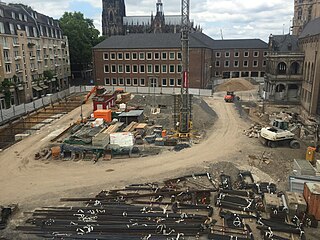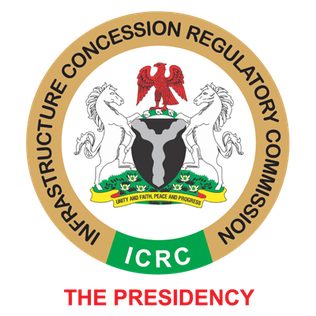
The private finance initiative (PFI) was a United Kingdom government procurement policy aimed at creating "public–private partnerships" (PPPs) where private firms are contracted to complete and manage public projects. Initially launched in 1992 by Prime Minister John Major, and expanded considerably by the Blair government, PFI is part of the wider programme of privatisation and financialisation, and presented as a means for increasing accountability and efficiency for public spending.

Construction is a general term meaning the art and science of forming objects, systems, or organizations. It comes from the Latin word constructio and Old French construction. To 'construct' is a verb: the act of building, and the noun is construction: how something is built or the nature of its structure.

A public–private partnership is a long-term arrangement between a government and private sector institutions. Typically, it involves private capital financing government projects and services up-front, and then drawing revenues from taxpayers and/or users for profit over the course of the PPP contract. Public–private partnerships have been implemented in multiple countries and are primarily used for infrastructure projects. Although they are not necessary, PPPs have been employed for building, equipping, operating and maintaining schools, hospitals, transport systems, and water and sewerage systems.
Build–operate–transfer (BOT) or build–own–operate–transfer (BOOT) is a form of project delivery method, usually for large-scale infrastructure projects, wherein a private entity receives a concession from the public sector to finance, design, construct, own, and operate a facility stated in the concession contract. The private entity will have the right to operate it for a set period of time. This enables the project proponent to recover its investment and operating and maintenance expenses in the project.
Design–build, also known as alternative delivery, is a project delivery system used in the construction industry. It is a method to deliver a project in which the design and construction services are contracted by a single entity known as the design–builder or design–build contractor. It can be subdivided into architect-led design–build and contractor-led design–build.
Design–bid–build, also known as Design–tender, traditional method, or hardbid, is a project delivery method in which the agency or owner contracts with separate entities for the design and construction of a project.

Downer Group is an integrated services company active in Australia and New Zealand.
Construction management (CM) aims to control the quality of a project's scope, time, and cost to maximize the project owner's satisfaction. It uses project management techniques and software to oversee the planning, design, construction and closeout of a construction safely, on time, on budget and within specifications.
Project finance is the long-term financing of infrastructure and industrial projects based upon the projected cash flows of the project rather than the balance sheets of its sponsors. Usually, a project financing structure involves a number of equity investors, known as 'sponsors', and a 'syndicate' of banks or other lending institutions that provide loans to the operation. They are most commonly non-recourse loans, which are secured by the project assets and paid entirely from project cash flow, rather than from the general assets or creditworthiness of the project sponsors, a decision in part supported by financial modeling; see Project finance model. The financing is typically secured by all of the project assets, including the revenue-producing contracts. Project lenders are given a lien on all of these assets and are able to assume control of a project if the project company has difficulties complying with the loan terms.
Lean construction is a combination of operational research and practical development in design and construction with an adoption of lean manufacturing principles and practices to the end-to-end design and construction process. Unlike manufacturing, construction is a project-based production process. Lean Construction is concerned with the alignment and holistic pursuit of concurrent and continuous improvements in all dimensions of the built and natural environment: design, construction, activation, maintenance, salvaging, and recycling. This approach tries to manage and improve construction processes with minimum cost and maximum value by considering customer needs.

Public/social/private partnerships are methods of co-operation between private and government bodies.
An energy service company (ESCO) is a company that provides a broad range of energy solutions including designs and implementation of energy savings projects, retrofitting, energy conservation, energy infrastructure outsourcing, power generation, energy supply, and risk management.
Integrated project delivery (IPD) is a construction project delivery method that seeks the efficiency and involvement of all participants through all phases of design, fabrication, and construction. IPD combines ideas from integrated practice and lean construction. The objectives of IPD are to increase productivity, reduce waste, avoid time overruns, enhance final product quality, and reduce conflicts between owners, architects and contractors during construction. IPD emphasizes the use of technology to facilitate communication between the parties involved in the construction process.
Fast-track building construction is construction industry jargon for a project delivery strategy to start construction before the design is complete. The purpose is to shorten the time to completion.

Infrastructure asset management is the integrated, multidisciplinary set of strategies in sustaining public infrastructure assets such as water treatment facilities, sewer lines, roads, utility grids, bridges, and railways. Generally, the process focuses on the later stages of a facility's life cycle, specifically maintenance, rehabilitation, and replacement. Asset management specifically uses software tools to organize and implement these strategies with the fundamental goal to preserve and extend the service life of long-term infrastructure assets which are vital underlying components in maintaining the quality of life in society and efficiency in the economy. In the 21st century, climate change adaptation has become an important part of infrastructure asset management competence.

Eagle P3 is a public–private partnership (P3) involving the Regional Transportation District (RTD) of Denver, Colorado and Denver Transit Partners, a partnership of several private companies. Under the Eagle P3 signed in 2010, Denver Transit Partners holds a 34-year contract to design, build, finance, operate and maintain RTD commuter rail lines.

The public–private partnership is a commercial legal relationship defined by the Government of India in 2011 as "an arrangement between a statutory / government owned entity on one side and a private sector entity on the other, for the provision of public assets and/or public services, through investments being made and/or management being undertaken by the private sector entity, for a specified period of time, where there is well defined allocation of risk between the private sector and the public entity and the private entity receives performance linked payments that conform to specified and pre-determined performance standards, measurable by the public entity or its representative".

The Hamilton LRT is a planned light rail line in Hamilton, Ontario, Canada, to operate along Main Street, King Street, and Queenston Road. It is one of five planned rapid transit lines which form Hamilton's proposed BLAST network. The 14 km (8.7 mi), 17-stop route is planned to extend from McMaster University to Eastgate Square via downtown Hamilton.

Public–private partnerships in Canada, is a form of alternative service delivery that involves a formal collaborative arrangement between the public and private sector in several initiatives, typically of a long-term nature. Public–private partnerships are commonly known for being used for infrastructure projects related to healthcare, transportation, the environment, justice & correction, recreation & culture, and education.

The Infrastructure Concession Regulatory Commission (ICRC) is an agency of the Federal Government of Nigeria responsible for the development and implementation of the Public-Private Partnership (PPP) framework for the provision of infrastructure services.











